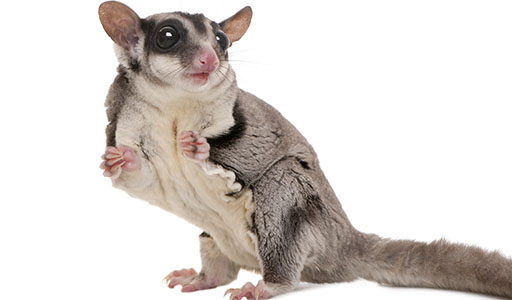Flying Squirrels

Flying Squirrel Information
Flying squirrels are known for their ability to glide from one tree to another with the help of a wing-like structure on their body. Despite being able to fly, these creatures are very similar to regular squirrels. However, flying squirrels tend to be nocturnal beings who subsist off of primaryily fruit, insects, and seeds. Flying squirrels build nests in trees to hold their young.

What do Flying Squirrel look like?
Flying squirrels are the smallest of all squirrel species. They have light brown fur, dark stripes running along their sides, and lighter cream-colored fur on their bellies. Small rounded ears and large dark eyes give them an attractive appearance. When they leap from tree branches, they extend their arms and legs and allow their webs of skin to catch the air. Flying squirrels use their furry tails for steering when in flight. The rodents rarely exceed 10 inches in length.

What do Flying Squirrels eat?
Similar to other types of squirrels, flying squirrels mostly feed on nuts, berries, and fruits, which are available to them without leaving their tree homes. Their carnivorous tendencies lead them to regularly eat baby bird eggs, as well as insects and the occasional small animal.

Flying Squirrel habitats
Forests throughout North America host flying squirrels. The creatures prefer to nest in warm, enclosed spaces such as hollowed out sections of trees, crevices, bird boxes, and abandoned bird nests. They live in large colonies that huddle together when they sleep in order to keep warm.
Frequently Asked Questions
Flying squirrels and sugar gliders look almost identical at first glance. Both animals have large eyes, fluffy tails, and are only about six inches long. They also have a thin membrane of skin that allows them to take long, gliding leaps from tree to tree. However, that’s where the similarities end.
Flying Squirrels
- Live across the Eastern U.S. and in patches along the West Coast
- Have gray-brown upper bodies and light-colored bellies
- Care for babies in nests after birth
Sugar Gliders
- Found wild in Australia or in the exotic pet trade in the U.S.
- Display a distinctive, dark gray stripe down their backs
- Keep young in a pouch after birth
In fact, despite their appearance, these pests are actually part of different families. Sugar gliders are marsupials, not rodents, and more closely related to kangaroos than flying squirrels.


